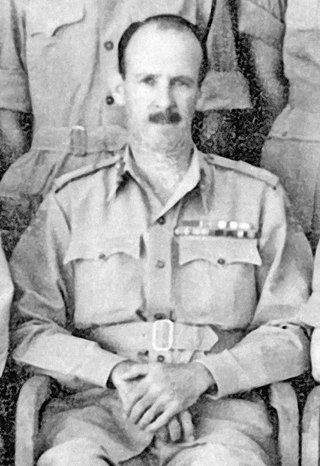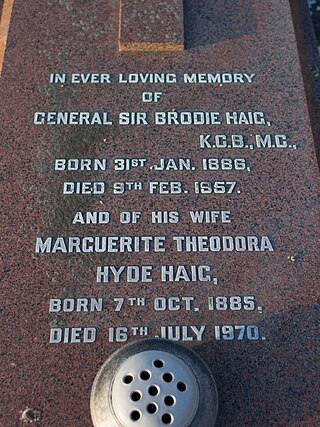Related Research Articles

Lieutenant General Sir William George Shedden Dobbie, was a British Army officer who served in the Second Boer War and the First and Second World Wars.

Field Marshal William Riddell Birdwood, 1st Baron Birdwood, was a British Army officer. He saw active service in the Second Boer War on the staff of Lord Kitchener. He saw action again in the First World War as commander of the Australian and New Zealand Army Corps during the Gallipoli Campaign in 1915, leading the landings on the peninsula and then the evacuation later in the year, before becoming commander-in-chief of the Fifth Army on the Western Front during the closing stages of the war. He went on to be general officer commanding the Northern Army in India in 1920 and Commander-in-Chief, India, in 1925.
General Sir Peter Edgar de la Cour de la Billière, is a former British Army officer who was Director SAS during the Iranian Embassy siege, and Commander-in-Chief of the British forces in Operation Granby.

Monkton Combe School is a public school, located in the village of Monkton Combe near Bath in Somerset, England.

General Sir Rob McGregor MacDonald Lockhart was a senior British Army officer during the Second World War and later the first Commander-in-Chief of the Indian Army upon India's independence.
Brigadier Charles Joseph Weld was an officer in the British Indian Army during World War I, the interwar years and World War II.
Major-General Roger Eustace Le Fleming was an officer in the British Indian Army during World War I and World War II. He was born at Tonbridge in Kent in 1895, the second son of John and Ethel Le Fleming. Le Fleming was educated at Tonbridge School, where his father was an Army tutor, and joined Royal Military College, Sandhurst in September 1913.
Lieutenant-Colonel Sir Armine Brereton Dew (1867–1941) was a British Indian Army officer and administrator in British India; he served as the Chief Commissioner of Balochistan during colonial rule.
Cuthbert Euan Charles Rabagliati,, was a British soldier, pilot, race car driver and intelligence officer. He served in the Royal Flying Corps (RFC) during the First World War and is credited as being the first RFC pilot to shoot down an enemy aircraft. As a racing driver at Brooklands in the 1930s, his crash was followed by the introduction of signs "Motor Racing is Dangerous" at all race meetings. During the Second World War he served as head of MI6's Dutch section.

General Sir Francis Robert Roy Bucher was a British soldier who became the second Commander-in-Chief of the Indian Army and the final non-Indian to hold the top post of the Indian Army after Partition.

Lieutenant General Timothy Paul Evans, is a retired British Army officer, who served as Commandant of the Royal Military Academy Sandhurst from 2012 to 2013 and then commander of the Allied Rapid Reaction Corps from 2013 to 2016.
Colonel William Murray Threipland, was a British Army officer. He was appointed the founding colonel commanding of the Welsh Guards in February 1915, and was the regiment's Colonel from March 1937.
Lieutenant-Colonel Sir Cecil Kaye was an officer in the British Indian Army.
Major-General Alexander Montagu Spears Elsmie CB CMG was a British Indian Army officer.
Brigadier-General Sir Terence Humphrey Keyes, was an officer in the British Indian Army and the Indian Political Service.

General Sir Arthur Brodie Haig, was a senior officer in the British Indian Army. A pre-war regular officer, he served in India prior to the outbreak of the First World War when he was posted to the Middle East. He was wounded at the Battle of Shaiba, twice mentioned in despatches and awarded the Military Cross (MC), before he was taken prisoner by the Ottoman Empire at the Siege of Kut. Escaping captivity in August 1918, he received a Bar to his MC.
Lieutenant-Colonel Arthur Kennedy Rawlins was a British Indian Army officer.
Lionel Carrington Bostock was an English first-class cricketer and British Army officer. He served with the Manchester Regiment and during the First World War was also seconded to the West African Frontier Force and the British Indian Army. After the war Bostock was seconded to the Egyptian Army and became commander of the Equatorial Corps of the Sudan Defence Force. In 1927–28 he led a punitive expedition against a rebellion of the Nuer people and successfully defeated a force led by Prophet Garluark. Bostock retired in 1933 but was recalled to service during the Second World War.

General Sir Robert Phayre G.C.B. was a General in the Indian Army who served most of his military career in India including in the First Afghan War, the Second Afghan War, the Indian Mutiny and who was Resident at Baroda from 1873 to 1874 during which period the Maharaja Gaikwar, Malhar Rao, precipitated the Baroda Crisis and then attempted to poison Phayre, by putting arsenic and diamond dust in his sherbet.
Lord Henry Francis Montagu-Douglas Scott was a Scottish first-class cricketer and British Army officer.
References
- ↑ Indian Army List supplement 1930
- ↑ Officer casualties of the Indian Armies 1803-1946 by A. J. Farrington
- ↑ Monkton Combe School register 1868-1965
- ↑ Monkton Combe School Register 1868-1965
- ↑ Curzon Collection: Views of the North-West Frontier and the Gilgit-Chitral Frontier. British Library.
- ↑ "No. 27997". The London Gazette . 19 February 1907. p. 1193.
- ↑ "No. 29119". The London Gazette . 6 April 1915. p. 3332.
- ↑ "No. 30451". The London Gazette . 1 January 1918. p. 83.
- ↑ Supplement to the Indian Army List January 1930
- ↑ Kennion, Roger Lloyd (1866-1942) Lieutenant Colonel Colonial Administrator National Register of Archives
- ↑ Person Page - 51372. The Peerage. Site accessed 24 June 2012.